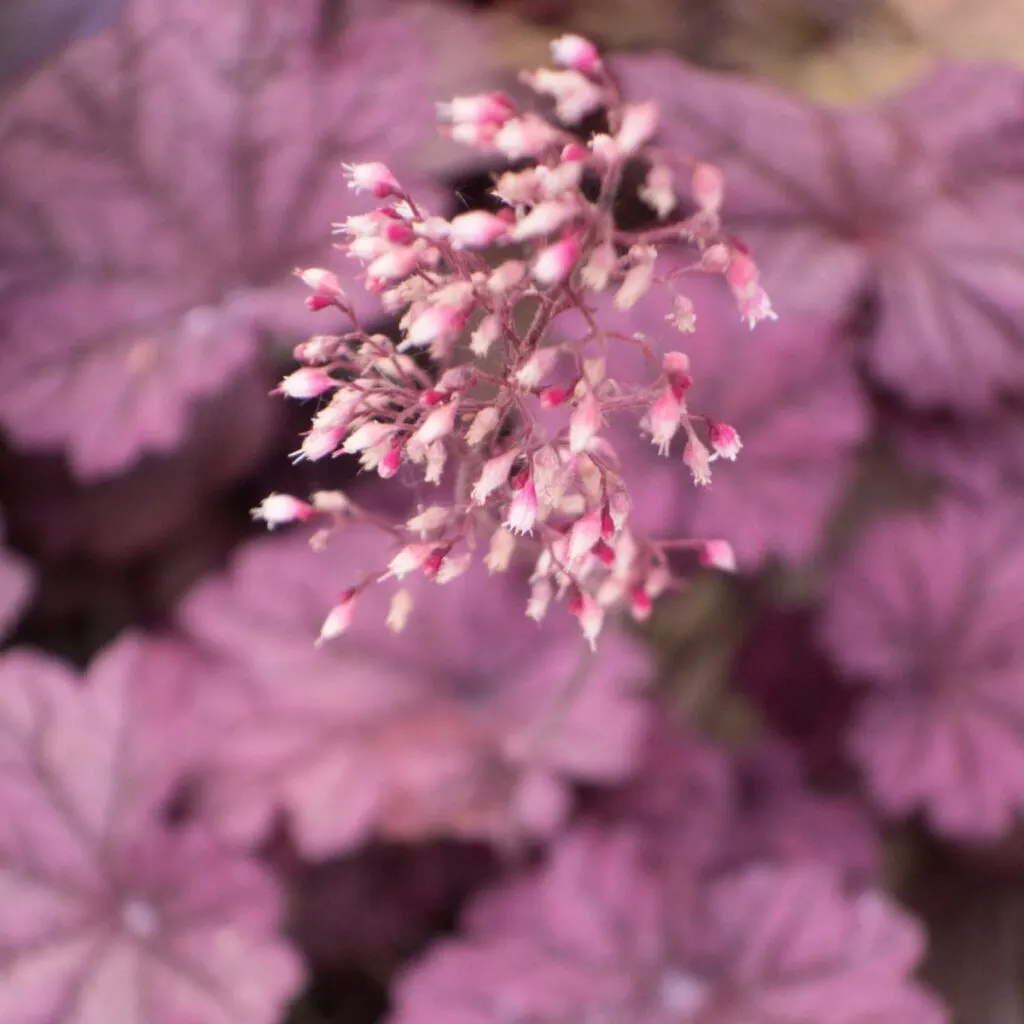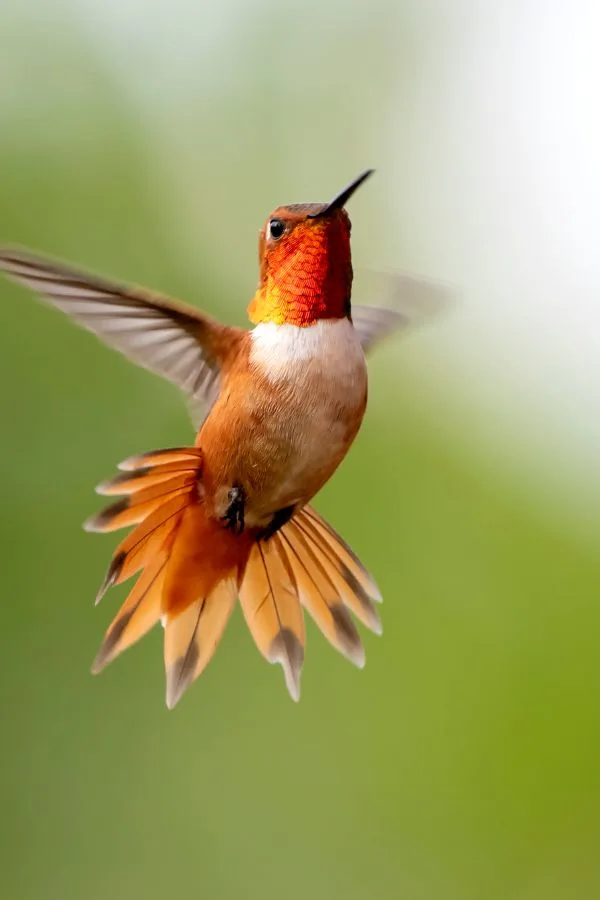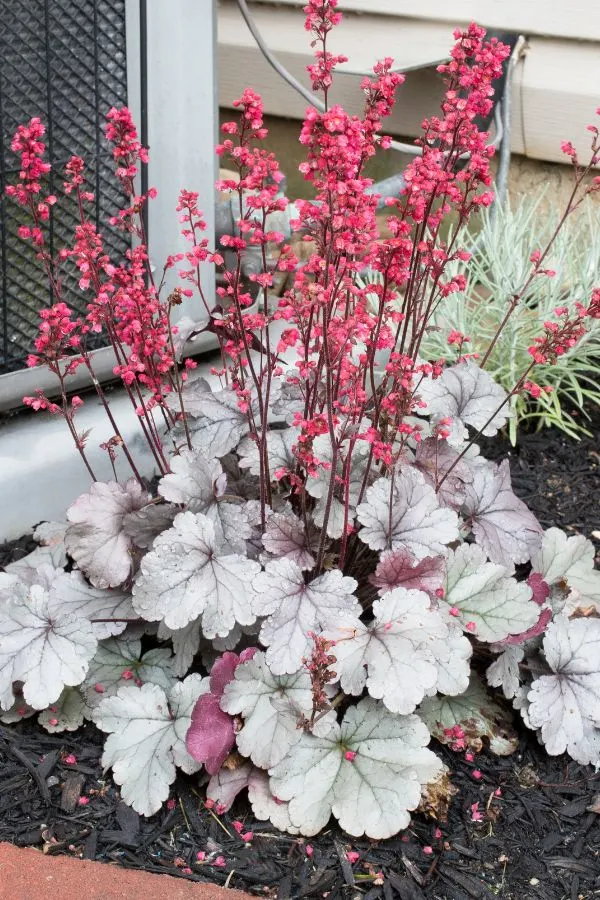If you are looking to attract more hummingbirds to your landscape, then planting and growing coral bells should certainly be at the top of your list. But as you will see with today’s article, these versatile, low maintenance perennials can bring so much more to your flowerbed and garden spaces than bringing in one of nature’s most fascinating birds!
Coral Bells are native to America and are known mostly for their beautiful, robust foliage and long, wispy bloom stems. They’re a great low-maintenance option for landscape beds and container gardens and can be found in a wide range of attractive colors.
The stunning plants not only add a pop of color and texture to your landscape but also serve as a magnet for charming hummingbirds. So, let’s dig a little deeper into the art of growing coral bells and explore some fascinating reasons why they make the perfect hummingbird plant.

Coral bells are well known for their diverse range of foliage colors, spanning from rich burgundy and deep purple – to vibrant lime green and even silvery shades. The wide variety allows you to create striking visual contrasts in your garden or as focal points in plant arrangements.
Their lush wide leaves also add a density and fullness to your garden and flower beds from spring till late fall – setting it apart from many other perennials that don’t always keep their foliage well maintained throughout the entire season. But it is their blooms that bring hummingbirds and other pollinators calling!
Growing Coral Bells- How To Attract Hummingbirds In Droves!
One of the most captivating aspects of growing coral bells is their ability to attract hummingbirds. These tiny, iridescent birds are drawn to the nectar-rich flowers, making coral bells an important addition to any hummingbird-friendly garden.
What exactly makes these flowers so popular to hummingbirds over other plants? For starters, the long delicate flowers of coral bells, which appear on tall stalks, provide the perfect platform for these creatures to feed on.
Hummingbirds feel safest when they can float and feed. And coral bells long bloom stems are ideal for this type of feeding. The tubular shape allows hummingbirds to insert their long bills and tongues to access the nectar deep within the flower.

Hummingbirds are also attracted to nectar-producing plants, and coral bells fit the description perfectly. The abundance of nectar reserved within coral bell flowers provide a dependable food source for these energetic birds.
Attracting Hummingbirds With Color – Growing Coral Bells
Coral bell flowers come in a range of colors, including shades of red, pink, and coral. These hues are irresistible to hummingbirds, as these birds are naturally drawn to bright and vibrant colors.
Even better, the blooms on the stems are not only long lasting, they continually open from bottom to top. This allows a consistent and lengthy feeding source for hummingbirds.
As much as hummingbirds they love coral bells, bees and butterflies will visit coral bells as well – bringing even more pollinating power to your flower gardens! We will cover more on attracting hummingbirds later in the article, but first – here is a look at how to plant and grow coral bells with big success.
Planting and Growing Coral Bells
Choosing the Right Location
When selecting a location for growing coral bells, consider these two main factors: sunlight and soil. Coral bells thrive in well-draining soil and prefer dappled sunlight or light shade.
Specifically, while coral bells can tolerate varying light conditions, they generally prefer morning sun and afternoon shade. This is especially in regions with hot summers. Ensure the soil is not over saturated with water and that it includes organic matter.

Also, sandy loam or loamy soil is ideal for coral bells. This is beneficial for coral bells, as it creates nutrient dense soil that can last long term. Coral bells do not need a lot of additional power, but having soil that has easy to absorb nutrients is a big key to long term success.
Planting Guidelines – Growing Coral Bells
When planting coral bells, provide adequate spacing to allow air circulation between plants. This helps prevent disease and encourage healthy growth.
Ensure the crown of the plant (where the stem meets the root) is level with the soil surface. Planting too deeply can lead to rot. As for mulch, apply a layer of organic mulch around the base of the plants to conserve moisture and suppress weed growth.
To keep roots safe, keep the mulch back from the main stems an inch or so. This will help to prevent too much moisture from sitting on the stem which can lead to rot.
Watering and Care – Growing Coral Bells
When growing coral bells, keep the soil consistently moist but not waterlogged, especially during the plant’s active growth phase. Aim to water at the base of the plant to avoid wetting the leaves.
Mulch not only helps retain soil moisture but also regulates soil temperature, which is particularly beneficial during temperature changes. Coral bells are relatively easy plants to take care of. You can also apply a balanced, slow-release fertilizer in early spring to provide a nice boost of nutrients – but it truly is not necessary as long as you are growing in soils with average to good fertility.

Creating a Hummingbird-Friendly Habitat – Growing Coral Bells
Although coral bells can bring in hummingbirds, be sure to include some other enticing plants that can keep them around for good in your planting plan. Specifically, pair coral bells with other sweet plants (bee balm, lupines, and petunias) to create a hummingbird-friendly habitat.
Include a variety of flower shapes and colors to cater to different hummingbird species. Again not only will it bring in hummingbirds, but other important pollinators too. (See: How To Attract Hummingbirds In Droves – And Keep Them Coming Back!)
Finally, consider adding a water feature such as a shallow bird bath or a small fountain nearby along with a hummingbird feeder. Hummingbirds need water not only for drinking but also for bathing to keep their feathers clean.

Growing coral bells is a great experience. It not only adds splashes of vivid color to your garden but also brings the beautiful presence of hummingbirds to your outdoor space.
These charming plants, with their colorfully elegant flowers and sweet blooms, provide a haven for hummingbirds. And, they can transform your outdoor space that you and your loved ones can enjoy each season. Here is to creating a flourishing habitat for both you and the hummingbirds with coral bells!
Follow Our Facebook Page For Even More Great Tips! Simple Garden Life Facebook Page
Simple Garden Life is a website dedicated to keeping gardening fun, simple and enjoyable! We publish two new articles each week along with a new garden podcast episode every two weeks. This article may contain affiliate links.
